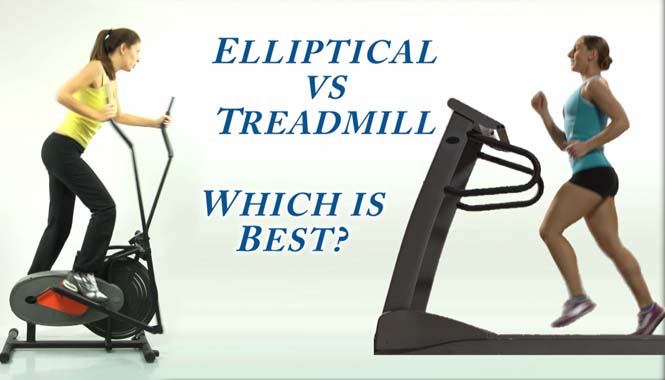

When we compare the cardiovascular workout we receive from an elliptical trainer and a standard treadmill, it has been shown in recent studies that neither can boast a difference. Elliptical trainers gained popularity early in the ’90’s and since then, enthusiasts have debated which machine is best. Since the cardiovascular benefits argument has been decided, we are now left with deciding between elliptical and treadmill by comparing the two a little closer.
Workout Intensity
Whether you use an elliptical machine or a treadmill, chances are you will burn the same calories. However, several recent studies found that there is a difference in how hard a user thinks they have worked. Those using a treadmill said that their ‘rate of perceived exertion’ (RPE) was more than an elliptical trainer.
The workout on an elliptical trainer feels more comfortable and easier, even though the same number of calories is being burned. A moderate RPE is measured when your heart rate is increased, but you are still able to hold a conversation. This appears to be harder to do on a treadmill.
Researchers suggest that this could be because an elliptical trainer works on a wider range of muscle groups. Muscle groups in the upper body work simultaneously with muscles in the lower body and you do not have any muscle group doing all the work at one time. Because of this, your perception of fatigue will be lower.
Beyond how hard we think are working, how hard do each of them really help our bodies work? All quality treadmills as well as elliptical trainers have intensity adjustments. Varied and challenging workouts are provided by elevation options and built-in programs so actual workout intensity can only be determined by each user.
Workout intensity by itself will not resolve the question for most people, but if this is your thing, watch this space for more information as it becomes available, that may help you decide between elliptical and treadmill.
Natural movement
Treadmill supporters argue the more “natural” movement provided by a treadmill. There is no special skill required other than our own bodies’ natural ability.
Treadmills provide a walking or running experience that simulates natural strides quite accurately, however, a closer look at how our muscles truly work on a treadmill reveals a different picture.
The moving belt cannot replace solid ground and it forces the front leg muscles to work a little harder with each stride. The gluteal muscles and hamstrings and are not engaged as they would normally be. Each time we walk or run, we push our bodies off the ground with each step, utilizing muscles, and stretching the tendons. While we still employ this pushing off motion on the treadmill, the moving belt reduces it. This can cause muscle imbalances that runners should be aware of and make sure they do not use a treadmill exclusively in their training.
Treadmill beds also come with varying types of cushioning. This is great for helping protect joints and making the run more comfortable, but for those arguing a “natural experience”, it doesn’t add up. When we run, the impact on landing can be up to 2.5 x’s our body weight and treadmills are designed to minimize that.
That being said, a treadmill cannot get rid of the impact completely, whereas elliptical trainers have been designed to do exactly that. They imitate the motions of our feet, but deliver no impact to the joints at all. They also simulate the natural hip rotation and the movements of our legs, but again, providing a low-impact workout. Because of this, elliptical training is ideal for injury rehabilitation.
Besides providing protection for the back and joints, an elliptical trainer can be actively beneficial to the joints as well. During an elliptical workout, the leg is put through a wider range of motion. As the muscles and tendons around the joints are strengthened and gain flexibility, the joints are strengthened too.
Mental Stimulation
There is nothing worse than getting bored during a workout. Staring at a wall for half an hour is not something anyone will look forward to and excitedly plan to do again.
Being able to vary a workout, to set goals and challenges, is essential to keeping you motivated.
Not only is it good for the mind, it is great for the body too. As your body gets used to a certain routine and accustomed to a set of movements, it becomes more efficient at carrying out that task, working less, and burning less calories.
Most high-quality treadmills offer fantastic programs including warm-ups and cool-downs, sprints, intervals and hills of varying elevations. Many of these are customizable, meaning that you can choose how hard and for how long you want to push your body.
Many of the best elliptical trainers now offer similar options. You can increase or decrease incline, resistance or speed. You also get to adjust the length of time spent on any intensity and still get to choose your workout as you could on a treadmill.
This “mixing and matching” on both machines allows for motivating and more challenging workouts. In addition, there is a definite advantage for runners on a treadmill. Runners have found treadmills, especially those with larger variety programs, have helped improve their endurance, conditioning and overall speed.
What a treadmill cannot do, however, is going backwards. An elliptical trainer can. You can change the direction of the foot pedals to exercise muscles in a completely different way. This not only makes an exciting addition to any workout, but it can also help correct, or prevent, any muscle imbalances either from injury or from exclusively running on a treadmill.
Both the elliptical trainer and the treadmill provide superior cardiovascular workouts. Both can help you burn calories, improve strength and endurance and both offer varied programs to keep you motivated, no matter what your fitness level. Considering the above, we hope we have been able to help you settle the treadmill vs. elliptical debate for yourself. Which one would you choose?











Leave a Reply
You must be logged in to post a comment.